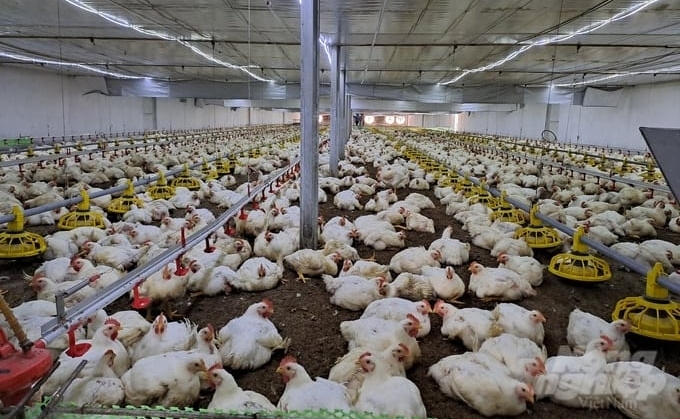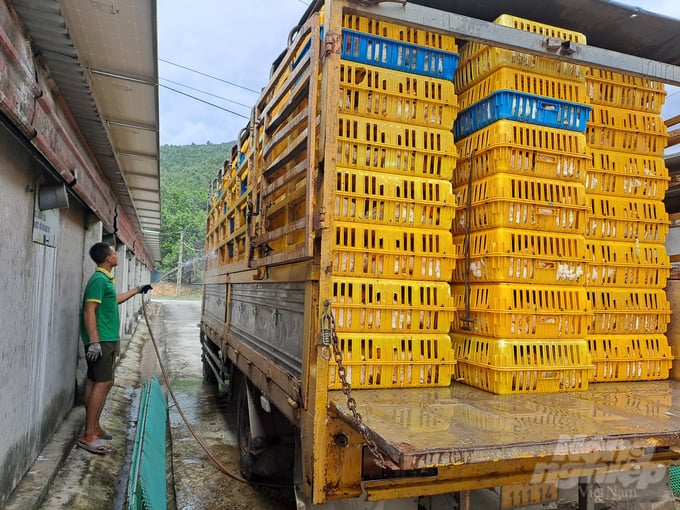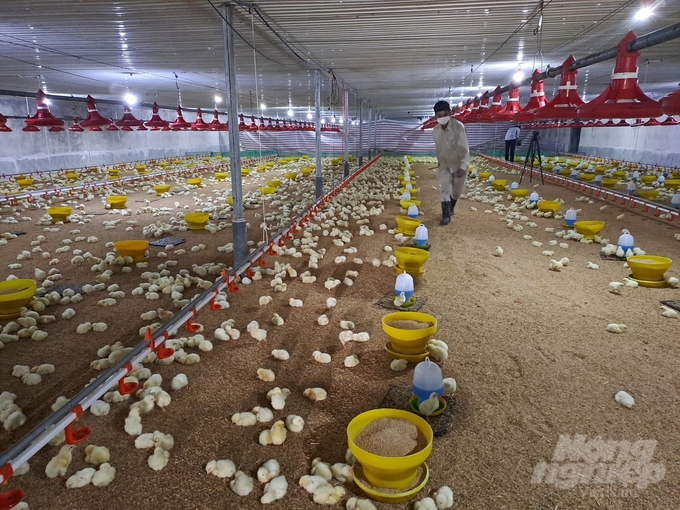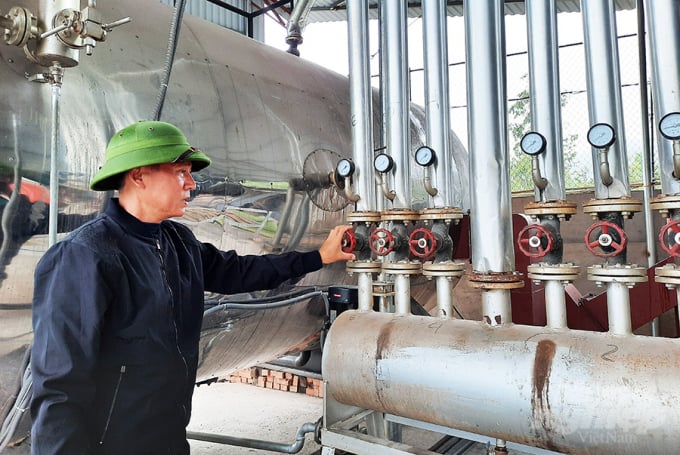October 7, 2025 | 14:15 GMT +7
October 7, 2025 | 14:15 GMT +7
Hotline: 0913.378.918
October 7, 2025 | 14:15 GMT +7
Hotline: 0913.378.918
In October 2020, with the support of Japfa Comfeed Group, Mr. Doan Van Chien started the construction of a high-tech chicken farm combining fruit tree planting, fish farming, and forestry in Tap Doan village, Thuong Yen Cong commune, Uong Bi City.
The farm has a scale of 6 hectares, and the investment value is about VND 20 billion. This is the first agricultural economic project Mr. Chien implemented. Previously, he specialized in the field of scrap iron and steel and construction materials.

Mr. Chien's chicken farm is raised using today's most advanced cold-house technology. Photo: Viet Cuong.
From the beginning, Mr. Chien's chicken farm was determined to raise using today's most advanced cold house technology.
Most of the equipment is imported from abroad or Vietnamese products with their designs, ensuring standard parameters and sustainable, long-term use with low operating costs...
During the raising process, it is essential to comply with the regulations: vaccination of chickens must be at the right age, dose, and type, and especially, do not miss the time of development of the chicken to avoid missing the golden time for the vaccine to take effect.
After exporting the chickens, the farm's workers will spend 15 days shoveling byproducts, drying used rice husks, spraying the barn floor, pushing hot air to dry the barn floor, spraying disinfectant chemicals, and waiting for a while. Space the cages according to regulations, then release the new litter.

Traders come to the farm to buy chickens. Photo: Viet Cuong.
With modern and strict farming technology and processes as above, Mr. Chien can control temperature, humidity, light, environment, diseases, food dosage... to ensure the growth of the chicken flock to stable throughout its 45 - 50-day life cycle. More importantly, almost the entire life cycle of the chicken will be lived in a safe, disease-free, and nutritious environment.
According to cost planning, each year brings in revenue of VND 6 - 7 billion, and profit reaches 30% of revenue, creating stable jobs for 10 local workers with an average salary of over VND 10 million/person per month.
It is known that Mr. Chien is preparing to invest in a phase 2 chicken farm, doubling the farm's capacity, doubling the area of fish ponds, and deploying net houses to grow clean vegetables and fruits and plant native forests and specialty plants.
As an irrigation engineer, he often travels from the South to the North, but Mr. Nguyen Ton Quyen is passionate and chose the hilly land of Uong Bi to raise high-tech chickens.
The chicken farm exported to the CP foods distribution channel (CP Vietnam Livestock Joint Stock Company) in Thuong Yen Cong commune, Uong Bi city, is one of the high-tech livestock models of Mr. Nguyen Ton Quyen. The scale of the chicken farm currently reaches 40,000 chickens per batch, raising 7 batches per year, with revenue of billions; The lowest profit is 10% of revenue, creating stable jobs for 12 people.

Mr. Nguyen Ton Quyen's chicken-raising model (Thuong Yen Cong commune) uses cold house technology, creating conditions for chickens to grow. Photo: Viet Cuong.
The basis to ensure the effectiveness of this chicken farm is a cooling system used in the summer, a heating boiler in the winter, a continuously operating ventilation fan, a disease detection system, and a ventilation system with suitable lighting, machines distributing and delivering food and water to the chickens...
Modern Danish equipment has helped Mr. Quyen control temperature, humidity, light, environment, and food dosage... ensuring stable growth for the chicken flock of about 6,500 chickens/coop throughout the 40 days of cycle life.
In addition to equipment and technology, the requirements for environmental sanitation and disease prevention for direct farming workers and farm supervisors are very high. One of the reasonable principles in animal husbandry used by Mr. Quyen is not to change cages or workers to limit pathogens that can cause disease. Chicken samples are taken weekly and sent to the laboratory of the consuming unit.

The heating system keeps Mr. Nguyen Ton Quyen's chicken barns warm. Photo: Viet Cuong.
With the current scale of the chicken farm including 6 cages, the initial investment cost of Mr. Quyen's chicken farm is up to nearly VND 40 billion. Currently, Mr. Quyen is preparing for the second investment phase, upgrading the scale of the chicken farm to double with 12 cages, a total investment of VND 80 billion, ensuring a total herd of 80,000 chickens/ batch.
The third investment phase with an additional investment of VND 40 billion, is for building food processing facilities, centralized slaughterhouses, cold storage to preserve products, and developing direct distribution channels to the market. grow fruit trees to use chicken by-products effectively...
Mr. Nguyen Ton Quyen's ambition is to have a total chicken herd of 500,000 chickens/year in Uong Bi by 2025 and his own chicken brand on the market.
According to Mr. Quyen, this is a scientific and feasible investment process with such a large investment in chicken farming, and the economic value brought is certain, high and sustainable. Mr. Quyen calculates the capital recovery period is 8 years. At least the next 12 years will be high profit because there is no investment cost.
Translated by Tuan Huy
/2025/10/06/3151-thuy-san-quang-ngai-dang-dung-truoc-nhieu-co-hoi-va-thach-thuc-khi-gia-nhap-thi-truong-quoc-te-182237_211.jpg)
(VAN) Quang Ngai's seafood exports are facing both opportunities and challenges from the stringent standards imposed by the EU and other major markets.
/2025/10/06/3816-2-152144_718.jpg)
(VAN) Each year, An Giang cultivates around 1.3 million ha of rice, with an estimated output of approximately 9 million tons, ranking first nationwide in both scale and productivity.

(VAN) The Department of Agriculture and Environment of Dak Lak Province recently held a working session with Netafim Group (Israel) to discuss precision agriculture solutions.
/2025/10/05/2416-1-001406_812.jpg)
(VAN) The Gia Lai Provincial People's Committee has issued Decision No. 1807/QD-UBND on the plan to implement measures to adapt to the EUDR within the province.

(VAN) De Heus strengthens its position in Asia with the acquisition of CJ Feed & Care, expanding into the South Korean and Philippines' market while reaffirming the commitment to independent livestock farming.
/2025/10/04/5737-2-075404_440.jpg)
(VAN) New technologies, environmentally friendly materials, and artificial intelligence are expected to provide sustainable solutions to protect riverbanks and coastlines in the Mekong Delta against the impacts of climate change.

(VAN) The climatic conditions in southern Khanh Hoa are rather unfavorable for traditional agriculture, yet they present a unique advantage for the development of high-tech and smart farming.